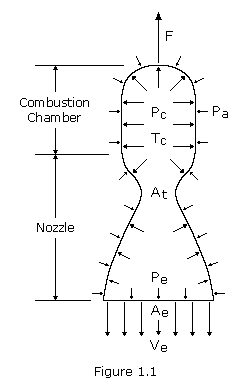Rocket Propulsion:
– Thrust
– Combustion & Exhaust Velocity
– Staging
.
Isaac Newton stated in his third law of motion that “for every action there is an equal and opposite reaction.” It is upon this principle that a rocket operates. Propellants are combined in a combustion chamber where they chemically react to form hot gases which are then accelerated and ejected at high velocity through a nozzle, thereby imparting momentum to the engine. The thrust force of a rocket motor is the reaction experienced by the motor structure due to ejection of the high velocity matter. This is the same phenomenon which pushes a garden hose backward as water flows from the nozzle, or makes a gun recoil when fired.

Figure 1.1 shows a combustion chamber with an opening, the nozzle, through which gas can escape. The pressure distribution within the chamber is asymmetric; that is, inside the chamber the pressure varies little, but near the nozzle it decreases somewhat. The force due to gas pressure on the bottom of the chamber is not compensated for from the outside. The resultant force F due to the internal and external pressure difference, the thrust, is opposite to the direction of the gas jet. It pushes the chamber upwards.
To create high speed exhaust gases, the necessary high temperatures and pressures of combustion are obtained by using a very energetic fuel and by having the molecular weight of the exhaust gases as low as possible. It is also necessary to reduce the pressure of the gas as much as possible inside the nozzle by creating a large section ratio. The section ratio, or expansion ratio, is defined as the area of the exit Ae divided by the area of the throat At.
The thrust F is the resultant of the forces due to the pressures exerted on the inner and outer walls by the combustion gases and the surrounding atmosphere, taking the boundary between the inner and outer surfaces as the cross section of the exit of the nozzle. As we shall see in the next section, applying the principle of the conservation of momentum gives
![]()
where q is the rate of the ejected mass flow, Pa the pressure of the ambient atmosphere, Pe the pressure of the exhaust gases and Ve their ejection speed. Thrust is specified either at sea level or in a vacuum.
—————————————–
PROBLEM 1.1
A spacecraft's engine ejects mass at a rate of 30 kg/s with an exhaust velocity of
3,100 m/s. The pressure at the nozzle exit is 5 kPa and the exit area is 0.7 m2.
What is the thrust of the engine in a vacuum?
SOLUTION,
Given: q = 30 kg/s
Ve = 3,100 m/s
Ae = 0.7 m2
Pe = 5 kPa = 5,000 N/m2
Pa = 0
Equation (1.6),
F = q × Ve + (Pe - Pa) × Ae
F = 30 × 3,100 + (5,000 - 0) × 0.7
F = 96,500 N